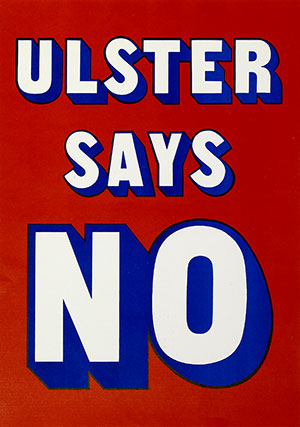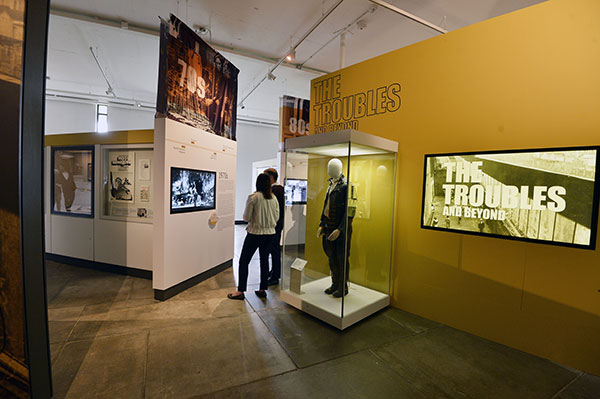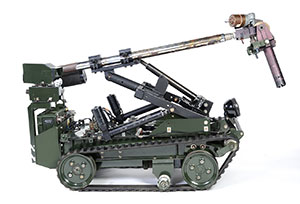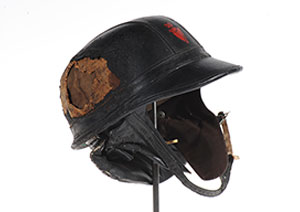MUSEUM EYE: The Troubles and Beyond
Published in Issue 5 (September/October 2018), Reviews, Volume 26Ulster Museum, Belfast
www.nmni.com/our-museums/ulster-museum
By Tony Canavan

Above: This iconic poster from 1985 featured heavily in unionist protests against the Anglo-Irish Agreement after it was signed at Hillsborough in November of that year.
To mark the twentieth anniversary of the Good Friday Agreement, the Ulster Museum has set up a new exhibition exploring the history of the Troubles, which examines Northern Ireland’s recent past through a range of objects reflecting diverse perspectives and experiences. Many objects were contributed by the public as part of a major collecting initiative, and the Ulster Museum collaborated with other museums, universities, community groups and the public on the project.
From the outset, it must be said that this is not an attempt to explain the Troubles or even to follow chronologically the events of these decades of conflict. This is a good thing, since any attempt to explain what happened, and why, unavoidably runs up against prejudiced views and bigoted opinion, not to mention honestly held interpretations, as politicians, journalists, historians and participants all have a different point of view. Even the information panels do their best to be scrupulously balanced in terms of terminology and descriptions of events. Instead, what is presented is an impression of what it was like to live through the Troubles, reflecting experiences across society.
The exhibition is conventional in layout, with artefacts in display cabinets, information panels with text (some of which are rather wordy) and screens with photographs from the different decades. One of the most striking things you see on entering the gallery are two ‘gable end’ murals from the streets of Belfast. One shows the death of legendary hero Cúchulain, depicting him as the modern defender of ‘Ulster’, and the other shows the death of a modern-day Republican, tied to a stone pillar just as Cúchulain is usually depicted. This not only shows the dispute there can be over symbolism but also starkly highlights the two sides involved in the civil conflict known as the Troubles.

Above: The exhibition is conventional in layout, with artefacts in display cabinets, information panels with text and screens with photographs from the different decades.
The exhibition is divided into decades from the 1960s to the 2000s. Major events, like the introduction of internment, Bloody Sunday, the Enniskillen bombing and so on, are represented through objects and often the testimony of those involved. The range of things on display is wide and represents both the trivial and the significant. While one case has caps, badges, an LP and a pipe bomb, another has an RUC helmet, riot shield and gun. Nearby may be a scrapbook of newspaper cuttings, one person’s attempt to make sense of what was happening, or propaganda posters from various groups.

Above: Bomb-disposal robot first developed in 1972 by retired Lt. Col. Peter Miller. From 1972 to 1978, 400 of these were destroyed while dealing with explosive devices. It is impossible to quantify the number of lives saved by Miller’s innovation, which, since its introduction to Northern Ireland, has been used around the world.
(All images: National Museums NI)
Each decade is introduced by text that puts Northern Ireland in an international context. The 1980s, for example, are introduced with paragraphs about the triumph of Ronald Reagan and Margaret Thatcher, the end of the Cold War and the dismantling of the Berlin Wall. The underlying message seems to be that Northern Ireland was stuck in the Troubles while the world moved on—although it might equally be that what was happening in the North was part of something bigger. Look out, too, for the ‘Stop & think’ yellow circles. For example, one highlights the idea of ‘an acceptable level of violence’, which invites us to consider how seriously the British government took Northern Ireland or what value was placed on lives there.
Alongside the items directly related to the violence and political developments, there are other displays that reflect the fact that there was more to Northern Ireland than the Troubles. Campaigns on social issues, like unemployment or the health service, are illustrated, as well as ephemera from sport and entertainment. Some attempt is made to show a ‘brighter’ side to the North, with displays on the boxing career of Barry McGuigan and the acting achievements of James Ellis. For a glimpse of an ‘alternative Ulster’ there is memorabilia of Punk music, in particular the Belfast band the Outcasts, and items related to gender issues and the campaign for gay rights.

Above: An early 1970s RUC ‘Skulgarde’ helmet, damaged by a petrol bomb during a street riot in Derry.
There is much more to this exhibition than can be described here. Anyone who has an interest in trying to understand what it was like to live through the Troubles should visit it. You will not leave with a clear insight or understanding of what it was all about, but that is not the purpose of the exhibition. I imagine that there will be some criticism—complaints that some things are not explained properly or that ‘they’ are better represented than ‘us’—but that is to be expected.
One criticism that I have is that there is little or no mention of the rest of Ireland. Given that pains are taken to put Northern Ireland in the international context, it seems strange that it is treated in isolation from the Republic of Ireland. After all, unity with the Republic was at the heart of the Troubles, and things happened in the Republic that affected events in the North, while every so often Northern violence spilled over into the Republic. Nevertheless, setting that aside, I commend this exhibition.
Tony Canavan is editor of Books Ireland.
















